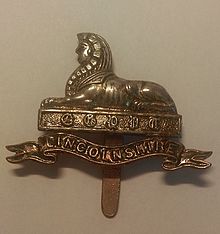10th regiment of foot
| Earl of Bath's Regiment 10th (North Lincoln) Regiment of Foot Lincolnshire Regiment Royal Lincolnshire Regiment |
|
|---|---|

Lincolnshire Regiment Cap Badge
|
|
| Active | 1685–1960 |
| Country |
|
| Branch |
|
| Type | Line infantry |
| Role | Infantry |
| Size | Varied |
| Garrison/HQ | Sobraon Barracks, Lincoln |
| Engagements |
Nine Years' War War of the Spanish Succession (Blenhein, Ramillies & Malplaquet) American War of Independence (Lexington, Bunker Hill, New York and New Jersey campaign, Germantown, Monmouth, & Rhode Island) French Revolutionary Wars Napoleonic Wars Peninsular War First World War Second World War |
The Royal Lincolnshire Regiment was a line infantry regiment of the British Army raised on 20 June 1685 as the Earl of Bath's Regiment for its first Colonel, John Granville, 1st Earl of Bath. In 1751, it was numbered like most other Army regiments and named the 10th (North Lincoln) Regiment of Foot. After the Childers Reforms of 1881, it became the Lincolnshire Regiment after the county where it had been recruiting since 1781.
After the Second World War, the regiment was honoured with the name Royal Lincolnshire Regiment, before being amalgamated in 1960 with the Northamptonshire Regiment to form the 2nd East Anglian Regiment (Duchess of Gloucester's Own Royal Lincolnshire and Northamptonshire) which was later amalgamated with the 1st East Anglian Regiment (Royal Norfolk and Suffolk), 3rd East Anglian Regiment (16th/44th Foot) and the Royal Leicestershire Regiment to form the Royal Anglian Regiment. 'A' Company of the 2nd Battalion of the Royal Anglians continues the traditions of the Royal Lincolnshire Regiment.
The regiment was raised on 20 June 1685 as the Earl of Bath's Regiment for its first Colonel, John Granville, 1st Earl of Bath. It embarked for Flanders in 1690 and saw action at the Battle of Steenkerque in August 1692 and the Battle of Landen in July 1693 and the Siege of Namur in July 1695 during the Nine Years' War before returning to England in 1696.
...
Wikipedia
